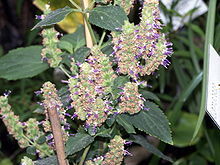Patchouli
| Patchouli | |
|---|---|
 |
|
| Scientific classification | |
| Kingdom: | Plantae |
| (unranked): | Angiosperms |
| (unranked): | Eudicots |
| (unranked): | Asterids |
| Order: | Lamiales |
| Family: | Lamiaceae |
| Genus: | Pogostemon |
| Species: | P. cablin |
| Binomial name | |
|
Pogostemon cablin (Blanco) Benth. |
|
Patchouli (Pogostemon cablin) is a species of plant from the genus Pogostemon. It is a bushy herb of the mint family, with erect stems, reaching two or three feet (about 0.75 metre) in height and bearing small, pale pink-white flowers. The plant is native to tropical regions of Asia, and is now extensively cultivated in China, Indonesia, Cambodia, Myanmar, India, Maldives, Malaysia, Mauritius, Seychelles, Madagascar, Taiwan, Philippines, Thailand, Vietnam, South America and the Caribbean.
The heavy and strong scent of patchouli has been used for centuries in perfumes and, more recently, in incense, insect repellents, and alternative medicines. The word derives from the Tamil patchai (Tamil: பச்சை) (green), ellai (Tamil: இலை) (leaf). In Assamese it is known as xukloti. In Kannada it is known as Pachhethene.
Pogostemon cablin, P. commosum, P. hortensis, P. heyneasus and P. plectranthoides are all cultivated for their essential oil, known as patchouli oil.
...
Wikipedia
